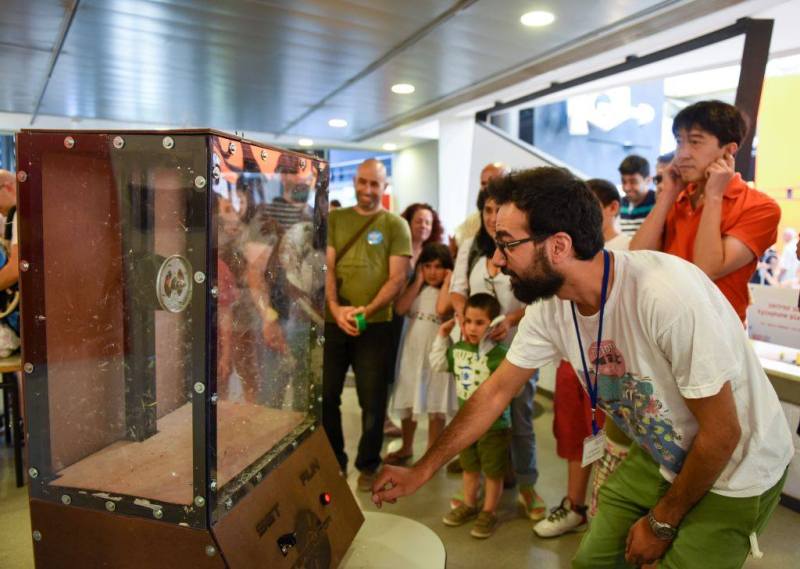Welded steel safety cage? Check! Polycarbonate blast shield? Check! Vacuum cleaner motor wired to an inviting red button? Double check! Stack of CDs to dispose of as destructively as possible? [Firas Sirriyeh] has got you covered with his CD Terminator 1.0.
While [Firas’s] build log is a little short on descriptive text, there’s really no need for it. His pictures tell the tale. The combination media shredder and interactive performance art piece is a stoutly constructed affair, which you’d want anything capable of flinging razor-sharp plastic and Mylar shrapnel to be. [Firas] has displayed his CD execution chamber at the Jerusalem Mini Maker Fair 2015 (in Hebrew; English link) and the Musara Mix Festival where the must-see video after the break was shot (mildly NSFW language). Some CDs give up the ghost very quickly, but one held out for a remarkable long time before finally exploding; you can see it flexing and warping in a way that almost appears to be slow-motion.
For those who’d rather not fuss with all that bothersome safety, there’s always this automatic CD launcher to play with.
















wow!
Exceptionally high bps erase rate.
it would be interesting to see if you could have it hold an RPM at it’s fastest rate just before the disc loses stability, and then apply heat and see how that changes things.. could a warm/hot disc put up with higher RPMs? given enough heat, will the diameter of the disc increase as it spins like pizza dough?
what kind of RPMs would it take for an HDD platter to destroy itself in the same way?
It could be very useful for HDD platters.
The normal erase routine – Do you want to erase all data on Drive 1: for 1), 3) or 5) days.
But I would expect that a HDD platter would be much more dangerous as it would hold together until a much higher RPM.
Hmmmm.
Hard drive platters are either made of aluminum or glass … let’s ignore glass, that’s less interesting. Aluminum’s tensile strength varies widely depending on how it’s tempered and whether it’s alloyed, but it’s seems to be at least 30MPa. A 3.5″ HDD has a platter size of (hm, I can’t find a good source, so let’s say) 3.4″. blah blah hoop stress and radial stress, looks like the tensile strength matches the radial stress at 15krpm … if the platter were made of ordinary untempered aluminum. It’s obviously not, since you could (still?) buy 15krpm drives.
It looks like tempering and alloying the aluminum gets you about a factor of two improvement in rotational velocity before failure.
HDD platters can spin a lot faster than their rated RPM, I think the reason they are limited is because of the air movement making the needle vibrate or something along those lines. It is so long since I learned about this..
Probably for the last 15 years at least, R/W heads have been on aerofoils so they fly over the platters. I don’t think their performance should change as long as they stay subsonic. Maybe finding higher speed bearings in the size they need becomes problematic.
Actually a lot longer than that, Leithoa. The principle is call the Bernoulli effect. The friction of a spinning disk against air creates airflow that moves in the direction of the disk’s spin. The read/write heads are designed to act as a wing generating lift on this airflow so that the skim the surface of the platter without touching it. There was actually a company in the 80’s called Bernoulli that made removable media and drives that used this principle.
They’ve started putting helium in enterprise HDD for reduced turbulence, see https://www.hgst.com/hard-drives/enterprise-hard-drives/enterprise-sas-drives/ultrastar-he8
Glass or aluminum platter?
I prefer https://www.youtube.com/watch?v=TlCCpCB-Gr4 … *veg*
that………was………AWESOME!!!!!
Your ‘Secondary’ column covers up you videos, its quite annoying
Finally a good use for all those Justin Bieber CD I keep seeing at Goodwill.
Wanna see what’s happening in Slo Mo, guys? :)
https://www.youtube.com/watch?v=zs7x1Hu29Wc
Those guys have done some interesting work.
I had a CD with a hub crack explode in a desktop drive. Made quite a bang. Knocked the cover plate loose on the tray. I took the drive apart, shook the confetti out, snapped the cover back in place. Worked fine after reassembly.
Mine didn’t. Killed the drive completely. It was one of those high-speed “100x” CD drives that were popular a long time ago. The thing wound up while I was booting the computer and then let off a heck of bang followed by some rather ugly mechanical noise. When I pulled the drive I found a chunk of disk that had partially cut through the steel case of the drive. The drive was completely dead, as the energy from the disk exploding had shattered the PCB and most of the mechanical parts.
The scary part is that I also found a large CD shard embedded in the wall behind me, at least 15 feet away. If that had hit me, who knows what damage it could have caused me. Thankfully drives don’t spin that fast anymore.
You were right to be scared. Mythbuster did a test on CD exploding about 12 years ago using a power tool to simulate max speed CD and a gel dummy next to it. Shards have gotten embedded deep. If the metal case of the CD drive doesn’t contain shards, hope you are not in the way!
I’ve had them explode in a desktop machine before as well!! It shot shards out of the faceplate! Just replaced the drive…
This is my second favourite terminator!
How did they mount the CDs to the motor spindle?